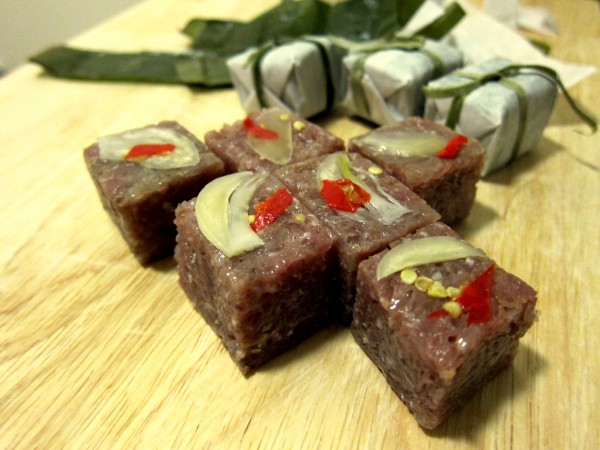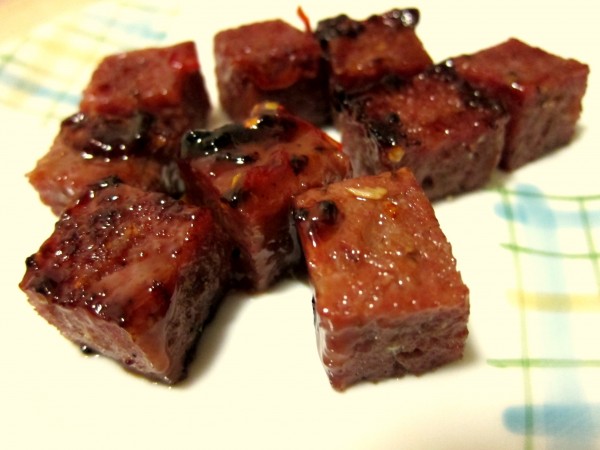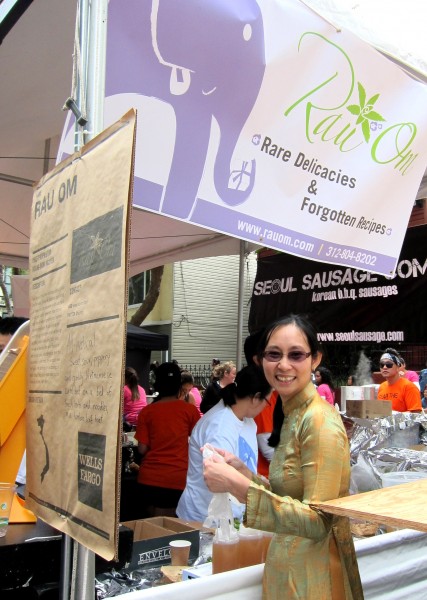
My most vivid memory nem happened one summer afternoon at a fishing park in the suburbs of Saigon. Nem is one of those more favored snacks to accompany conversations among friends, and while the adults were toasting away the sunlit hours grilling their freshly caught fish, the ten-year-old Mai made friends with this tiny black-haired guy with her share of nem. He enjoyed the nem so very much that he kept reaching out to her and holding her finger. Oh it was such joy watching him nimbly bite into the succulent pink pieces of meat, smiling innocuously. It’s been fifteen years. I wonder how that little pet monkey is doing now. His hair is probably all white, if he’s alive.
I didn’t have much nem to give him, maybe two or three pieces, each the size of half a thumb. Little Mom had no idea that I was giving them to the monkey, she probably would have given me more if she did, because she’s very hesitant to let me eat nem. First, it’s uncooked meat. Second, ambiguous chemicals are involved in the curing process to make nem. So aside from that happy memory of nem and monkey, Mai grew up indifferent toward those pink meat snacks wrapped in banana leaves. But one day, the twenty-five-year-old Mai, while reading Rau Om, saw that her blogger friends have discovered an all-natural, chemical-free way to make the meat snacks, and the interest arose.
In my previous post, which was a hundred years ago due to web hosting issue, I mentioned that Rau Om‘s nem was the main reason I joined the San Fran Street Food crowd this August. If there’s anything I regret not doing that day, it would be not eating the nem the way Oanh and Dang prepared it at the festival: on bánh hỏi, with rau răm and a dash of mixed fish sauce, in a bamboo leaf boat. I didn’t have bánh hỏi and rau răm at home, so I just ate nem solo out of the leaf. I was surprised by how good it was.
Eaten soon after the curing time finished, Rau Om‘s nem has merely a quick hint of sourness, one paper thin slice of garlic and another of cayenne pepper still smell crisp, and the grease from the pork skin and the beef keep all of those flavors linger on the tongue. It’s intriguing to say the least. But most importantly, Oanh and Dang did not use any random “nem/nam seasoning package” in Asian grocers, which has always been known as the crucial ingredient to make nem. They are scientists, and they do experiments to replace the black box with natural ingredients. As it turns out, there’s only one special ingredient.

Oanh’s answers to my questions about Rau Om’s all-natural nem:
FB: What ingredients did you put in your nem? I know there’s ground beef, pork skin, garlic, chili pepper, salt, sugar, but is there anything else?
Oanh: The only other ingredient we add is celery juice powder (which is exactly what the name indicates, powder made from celery juice), which helps cure the meat and also prevents spoilage. Otherwise, there’s absolutely nothing else. That was the whole point of all our research into making nem the traditional, all natural way.
Also, the ground beef isn’t the regular ground beef. We actually bought whole lean eye round and ground it finely (twice or three times). This is where nem is different from regular sausages: nem can’t be made with regular store-bought ground beef because there’s just too much fat and connective tissues, it messes up the nem texture. With high quality lean meat, nem is more like ground ham than sausage.
FB: How long is the fermentation/curing process?
Oanh: 2-3 days
FB: How long can nem stay good after cured?
Oanh: If you put it in the freezer right away, it could keep for 2-3 months. Thawing should be done in the fridge and nem consumed within 3-5 days.
FB: How would things be different if you use pork instead of beef? Can chicken be made into nem?
Oanh: Pork and beef are neutral tasting enough that it doesn’t make a tangible difference in nem. We also make lamb nem, where we can taste the difference because lamb is a pretty assertive meat (grill lamb nem is really fragrant and yummy). Good question about chicken – I don’t think it’ll work, Dang thinks there’s only one way to find out. Also, now he wants to try duck nem.
FB: Usually, nem has a bright reddish hue, but Rau Om’s nem is more brown with a pink tint. Is this because you didn’t use the seasoning package?
Oanh: We are still tinkering with the process to get the color to be more pink. Most recent batches got a bit little bit more of the pink hue. I don’t think we can ever match the color of nem made with the nem powder, though. The amount of nitrate in that powder package is probably really high…too high for us to feel comfortable matching.
FB: Why does nem have to be individually wrapped in small packages like that? Is it to aid the curing process or just to make them easy to eat?
Oanh: I think just easy and convenient to eat on the go as a street snack. There are also bigger rolls of nem (just like we have bigger blocks) for eating at home, so the smaller packages aren’t necessary for curing.
FB: Does the banana leaf help enhancing the flavor/curing? Would it be okay to wrap it with foil or something beside banana leaf?
Oanh: In fact, most of the nem you find in Vietnamese delis in San Jose would be wrapped in foil and/or saran wrap. Even the banana leaf wrapped ones have the leaf itself wrapped in saran wrap. What we found was that direct contact between the leaf and the nem does give nem a distinctive flavor.
Nem also used to be wrapped with lá vông (tiger claw leaf), lá chùm ruột (star gooseberry leaf), or lá ổi (guava leaf). We haven’t been able to get lá vông, but we have experimented with lá ổi and cherry leaves. Speculation: these leaves don’t impact the flavor as much as provide the ingredients and enzymes that helps with curing, playing the same functional roles as the celery juice powder.
Honestly, I’m still not sure what celery juice powder means, so I’ll bug her to show me next time I see her. And how did she even think of celery juice powder? Lots of admiration sent her way. 🙂

I did my share of nem experimenting. Not having a grill or any appropriate grilling facility, I threw a handful of nem onto a skillet smeared with hot oil. Little Mom did warn me about pork skin and oil in the past, so I wore long sleeve shirt, wrapped both hands in plastic bags, stood three feet away from the burner, and used long chopsticks to flip the nem. Midway through the frying session, I also had to use a chopping board as a shield between me and the skillet. The aftermath was a stove with as many oil dots as stars in the Milky Way. I’m not kidding, frying nem was like lighting fireworks. But they go great with white rice and kimchi. 🙂
My clumsiness aside, making nem is not easy, and making nem without chemicals has been unheard of, but Oanh and Dang have succeeded in reviving the lost art of all-natural Vietnamese meat curing. I felt excited just being one of the many tasters of Rau Om‘s nem. The same kind of excitement I had playing with that pet monkey in the fishing park. If you’ve held hands with a monkey, you know it’s like a human hand, but it’s not, isn’t it the strangest feeling? Well, nem is raw meat, but it’s not, isn’t it an interesting food? 🙂
Disclaimer: The author of this post did not receive any monetary profit for writing about the product, so if you decide to trust her taste, you can buy Rau Om‘s nem online at rauom.com. $20 for a package of ten nem. 🙂
DISCLAIMER: I received no free product or monetary gift in exchange for this review.




Thanks for the write-up, Mai. My mom never lets me have any nem either, even though they always look so delicious when munched on by everyone else on the bus or the sidewalk.
Celery juice powder is actually a common ingredient in all-natural hams and sausages as plant materials are a natural source of a key curing ingredient. Celery juice just happens to have high enough concentrations of that salt so the amount needed doesn’t add celery flavors to the final product.
We only pasteurized for the Street Food Fest because we were unsure about refrigeration conditions we would encounter during the day. The pale pink color of our nem is more the result of a natural cure. We’re still researching ways to improve the color within our “all natural” constraints, but we’re never going to match the pink of other nem.
Thanks for the share. I miss nem already!
Thanks, Mai, for taking time to write the review. Sorry I forgot to tell you about not needing to use oil to pan fry nem. Hope the clean up wasn’t too bad. Oh, and I hope you had nem (fresh and pan fried) with a beer or an alcoholic drink of some sorts. That’s another thing a 25-yr-old Mai can enjoy that a 10-yr-old Mai couldn’t :D. Nem really is an addictive drinking snack.
@Dang: Thanks for the correction, I’ve updated the post. I just moved host recently so somehow I didn’t get any notify about new comments, so I had no idea that you commented. Sorry for the late reply! What I don’t understand about celery juice powder is how do you get powder out of juice?
@B: want me ship you some? 😛
@Oanh: hehe nah the nem was definitely worth the cleaning up and more. 🙂 I don’t drink though, so I had nem with sikhye. 😛